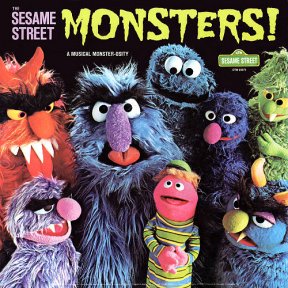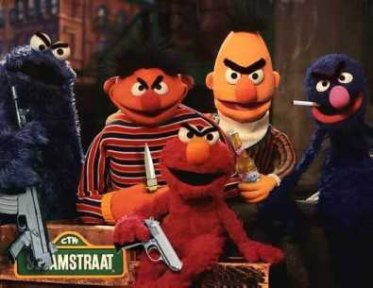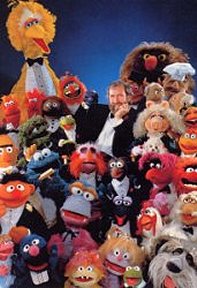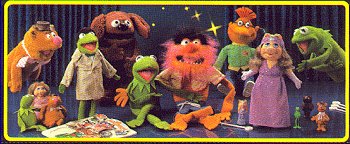

What sort of animals are Muppets? Well, obviously, they're
just jumped up sock puppets, constructions of coloured felt with google
eyes and hands up their insides. They're the creations of Jim Henson,
Frank Oz and their cohorts.
Okay, fine.
But let's pretend.
Let's pretend that the monsters of Sesame Street are real animals.
Real animals are not simple inventions, but rather, they have pasts
and futures, they have consistent discernible traits, which allow us to
identify where they come from and where they fit on the tree of life, their
traits are adaptations to their environment, and these adaptations allow
us to understand both that environment and their relationship to that environment.
Of course, Sesame Street has, over the years, had several hundred Muppet
characters. Some of whom are explicitly supposed to be humans, or human
analogues, and some of which don't really allow for classification.
But there are a quite a few that might stand up to some critical analysis.
Most obviously, there's Big Bird, a large flightless avian, and
Snuffleuphagus,
a pygmy mammoth.
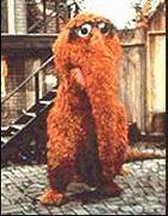
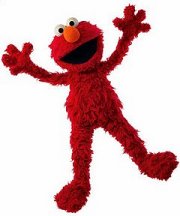

But there's also a very interesting series of creatures include Grover,
Elmo, Oscar, the Cookie Monster and others. It's pretty obvious
that Grover and Elmo are the same sort of animal, based on broad resemblance
and physical characteristics. But a closer look suggests that Oscar
the Grouch, for all his personal idiosyncrasies, shares most or all of
the traits. Even the Cookie Monster, a massive creature who
is a far cry from the delicate Elmo, seems to be related and fundamentally
the same sort of creature.
Indeed, a great many of the Sesame Street creatures who are explicitly
not ‘something else’, birds, humans, bugs, aliens, etc., seem to fall into
a common mold, they show enough consistency of traits that we could describe
them as a species. Let's call them collectively, the Sesame Street
Monsters.
We will note that in addition to the narrow set of monsters that we're
focusing on, there are outlier creatures. Animal, the wild
drummer, for instance, has prominent teeth, unlike most Monsters.
Others have floppy ears, or apparent horns, or furless hides.
These are obviously a second order of creatures, related to the Sesame
Monsters, but different. I think that we can explain these as well.
But for now, its more useful to focus on what I would consider the ‘core
group’ of Monsters. The outlier creatures might be better understood
and explained in terms of appreciating and understanding the main species.
So, in those terms, let us begin our journey by examining the Sesame
Monsters themselves.
The Monsters of Sesame Street
What are the consistent traits of the Monsters? Well, they're
small, adults ranging from thirty to sixty pounds in weight.
Some individuals, notably Elmo and Grover seem quite thin, others like
Oscar the Grouch are heavier and more physically robust, while still
others like the Cookie Monster show signs of obesity. I would argue
however, that these differences in build represent individual variation,
similar to that found in humans, rather than evidence of different types
of species.
They're covered with woolly fur which extends over the faces, leaving
only eyes, nose, and mouth bare. The fur colour varies from individual
to individual, but is usually uniform on individuals.
On some, there can be uniquely coloured or thick eyebrows, or scalp
tufts, but these are a minority. There's some variation in facial
features and contours, for instance, Oscar lacks a prominent furless nose.
They are tail-less, or at best, have only small vestigial tails.
They have round heads with gaping froglike mouths, flat featureless inner
mouths and concealed esophagus, and prominent, even protuberant eyes.
The nose seems to be a vestigial muzzle, lozenge shaped, prominent,
but featureless. Their teeth do not appear to be strongly in
evidence in most individuals, and are either absent or concealed between
the lips and the inner mouth pad.
Their shoulders and upper torsos are narrow, but their arms are long
and flexible. The legs seem comparatively short. They
have only four digits instead of five, one of which is a poorly differentiated
thumb.
Behaviorally, they appear to be intelligent, but their intelligence
is on the order of small children, or clever primates. They're predominantly
left handed, suggesting consistent right-brain hemisphere domination.
They are highly linguistic.
So, what does this tell us?
Numerous factors suggest an arboreal life style. If their
brains are wired anything like hominids or primates, right-brain dominance
suggests an emphasis on spatial relationships which are critical for tree
dwellers. The comparatively long arms, and the sweeping movement
ranges of the arms, up, out and around, suggest tree climbers and branch
huggers.
The reduction from five delicate fingers, to four heavier and stronger
digits suggest an evolutionary history where having a powerful grip was
more important than fine dexterity. In short, their lifestyle
would seem to be more along the lines of holding on, hugging tree trunks
and branches, and moving carefully and deliberately. This in
contrast to the swinging lifestyle of gibbons, and the free climbing of
monkeys. What this may resemble most are the ‘tree-lifestyles’
of sloths, koalas and raccoons. Instead of swift climbers and
swingers, they are clamberers.
In contrast the arms, their legs are shorter and bandy, suggesting adaptation
towards tree climbing. When on the ground, they are clumsy bipeds,
with short bouncing strides. Clearly, their upper bodies are
so oriented towards tree hugging and clambering that they find quadrupedalism
awkward.
The large google eyes suggest binocular vision. Another indicator
of tree dwelling lifestyle... the ability to judge distances finely is
crucial. However, the large eyes themselves seem to suggest that
these are, or were originally, nocturnal creatures. One interesting
feature is the diminutive or absent ears on most.
The shape of the mouths, and the apparent small or invisible teeth is
suggestive. First, we can rule out carnivores, who require
prominent cutting and shearing teeth. But even herbivores require
heavy duty teeth. Chomping and crushing heavy cellulose fibre takes
a lot of effort. Elephants, Horses, Moose and Oxen are
all chewing on tough grasses and leaves, reducing them to digestible paste.
An elephants teeth weigh twenty pounds apiece, and they take a lot of punishment.
The fact that the Monsters for the most part do not have prominent teeth
(arguably, some varieties do) suggest that they've got a fairly specialized
diet, perhaps soft rain forest leaves, fruits, berries, tender shoots,
etc.
The wide froglike mouths suggest that they sometimes, or often, consume
in bulk. If they're eating one leaf or berry at a time, well,
you don't need a big mouth for that. If you're stuffing food
in, then that suggests you're taking mouthfuls at a time. This
implies a primary diet of soft leaves or large fruit. The apparent
large flat inner mouth suggests a tough but flexible mouth lining and a
feeding reflex which swallows big gulps when the mouth closes.
However, in contrast to the small teeth, they appear to have large heavy
jaws, implying steady, even rapid chewing. Humans are traditionally
the most delicate eaters, practically all our diet is highly pre-processed,
so we have comparatively small jaws. Most other primates, even frugivores,
tend towards heavier jaws.
We note that even the juveniles tend to be pear shaped. Basically,
large bottoms, narrow shoulders. Again, this implies
a digestive process that emphasizes or allows for volume, and perhaps a
long bowel system for food processing. Again, this points to
soft leaves as a large component of diet.
Gorillas are generally leafy green eaters, but there's not much food
value in that stuff, so they have to eat a lot of it. Which
means that they've both got to spend a lot of time eating, and they've
got to have pretty full stomachs for comparatively paltry returns.
Gorillas are prone to being pot bellied for this reason, much like the
Monsters. On the other hand, Chimps are much more strongly
frugivores (fruit eaters). It's a highly specialized, but much more
high energy diet, so the chimps don't need to eat as much. They get
a bigger bang for their buck... so no pot-bellied chimps. Again,
the Monsters physical morphology suggests that their lifestyles are tending
to resemble sloths or koalas, or even pandas.
On the other hand, the behaviour of the Monsters seems more energetic
than sloths or koalas or pandas. They're outgoing, curious and even
inclined to seek out high value foods like cookies. This suggests
that while their adaptations allow a ‘soft-leaf’ diet, their tastes are
considerably more diverse. Unlike Koalas and Pandas, they probably
are not restricted to a single brand of plant, but might take advantage
of a variety of food sources, different fruits, berries, different sorts
of bamboo shoots or leaf sprouts.
The woolly fur suggests both high humidity and wide temperature ranges.
They're rain forest creatures, but sometimes it gets cold.
What are they?
First things first, they're obviously primates.
But what kind?
Taxonomically, we can broadly look to four categories of primates.
Hominids, Apes, Monkeys and Prosimians.
To start, we can pretty much rule out hominids. Homo Florensis
aside, there's nothing in the hominid line that would lead to anything
like them. There are a number of divergences, the wide mouth
and heavy jaw, the absence of forehead, the prominent eyes, the fur covered
face, all of which suggest that they're not hominids, or if they are, they're
a pretty radical branch off the family tree.
Apes? Well, like Apes and Hominids, the Sesame Monsters
are tail-less. But its pretty clear that the gap between the
Monsters and Great Apes is as big as that between the Monsters and Hominids.
Still, there is arguably a resemblance between the lesser apes, the Gibbons,
and the Monsters. On the other hand, the Monsters don't seem
as highly adapted as the Gibbons to a tree swinging lifestyle...
Or more accurately, they're differently adapted. The two
species have taken different paths. This is an important consideration.
A particular lifestyle or evolutionary pathway demands specialized adaptations.
Try to change the lifestyle, and those adaptations become handicaps.
Evolutionarily, an animal would literally have to evolve backwards, retracing
its steps to a more generalized form, and then proceeding forward down
a different lifestyle fork. That's hard to do, particularly
when the more generalized forms are still around and competing.
Thus, highly specialized animals tend to either remain as they are, or
become even more highly specialized in the directions that they're already
going.
What this means is that Gibbons are already highly specialized for a
particular kind of lifestyle. They're committed to their path.
It would not be easy for them to evolve radically in a different but similar
lifestyle. A Gibbon that went down the sort of pathway that
produced the Sesame Monsters, would only produce a slightly different kind
of Gibbon.
The best we can say is that Gibbons and Sesame Monsters had a common
ancestor whose offspring went off in two different directions and made
different commitments and trade offs in their lifestyles. The
same goes for the Great Apes and Hominids.
I'll also leave out monkeys for the same reason. The Monsters
are tree huggers rather than nimble tree climbers like monkeys. On
the ground, monkeys are fully quadrupedal, not poorly bipedal.
It's possible that some line of Monkey went down the Sloth/Koala road,
but there's no clear precedents. Besides which, monkeys, as well
as apes and hominids are di-urnal (day) creatures, and their faces are
furless. Again, the Sesame Monsters seem to be a parallel line to
monkeys, not an offshoot of them. So we have to look further
back for a common ancestor.
So what's left? Prosimians. This is the original
primate line that gave rise to Old and New World Monkeys, Apes, Hominids.
Modern prosimians include the Lemurs of Madagascar, and the Tarsiers of
Asia, Lorises, Pottos and Galagos of Asia's and Africa's rain forests.
A number of the pro-simian characteristics seem to match up with the
monsters. Their faces, like the Monsters, are fur covered, rather
than naked like other primates. As a group, they tend to be nocturnal
with large eyes. Several of them, notably the Lorises, Pottos
and Tarsiers have round heads and flat faces, with small ears. The
Lorises and Pottos are notably tail-less or stump-tailed, and are slow
moving clamberers. Some of the extinct lines of lemurs evolved
specialized lifestyles similar to sloths and koalas.
So, did the Sesame Monsters evolve from those Lemurs? Nope.
The Lemurs of Madagascar went off in their own direction. But they're
close enough to a starting point, to a common ancestor, that some of their
representatives embraced similar lifestyles.
In fact, the best and closest analogue to the Sesame Monsters are the
Lorises and Pottos. Compare this Wikipedia description to the
characteristics of the Sesame Monsters:
“Lorides have a close, woolly fur which is usually grey or brown colored,
darker on the top side. The eyes are large and face forward. The ears are
small and often partly hidden in the fur. The thumbs are opposable and
the index finger is short. Their tails are short or are missing completely.
They grow to a length of 17 to 40 cm and a weight of between 0.3 and 2
kg, depending on the species. Lorids are diurnal and arboreal.
Unlike the closely related galagos, they have slow, deliberate movements
and never jump. With their strong hands they clasp at the branches and
cannot be removed without significant force.”
Note the woolly fur, the round heads, large forward facing eyes, the
short or missing tails, the reducing finger, slow deliberate movements
and strong grip. There's more than a passing resemblance.
This is probably the starting point of the Sesame Monsters.
Did the Sesame Monsters evolve from Lorises? Nope, not quite.
For one thing, Lorises are a specialized species on their own, they're
clearly smaller, they are day-walkers, and they're opportunistic insectivores
and predators. But clearly, modern Lorises are closely related
to the Sesame Monsters.
So, we can safely assume that they belong to the same family, Lorisidae,
and spring from a common, ancestor which was probably quite Loris-like,
which may have also been an ancestor for Lemurs, New World Monkeys, Old
World Monkeys, Apes and Hominids. In short, they represent
a sixth major line of primates.
Now, Loris’ themselves, along with other Pro-simians like the Pottos,
Tarsiers, Galagos etc. are pretty much losers in the evolutionary sweepstakes.
Sure, they've managed to hang on in isolated and specialized niches.
But for the most part, they've been pretty thoroughly crowded out by their
more advanced and aggressive cousins, the monkeys and apes.
Indeed, the only place where the Pro-simians really came into their
own was in Madagascar, where the Lemurs, without competition, had an evolutionary
flowering, producing dozens of species and occupying niches of monkeys,
woodpeckers, sloths and apes.
Interestingly, if we look to the closest evolutionary analogues to the
Sesame Monsters, the sloths and koalas, we find that both of these evolved
on Island Continents which were outside the big mainstream of evolution.
This suggests that the Sesame Monsters in order to have evolved as far
and become as sophisticated and specialized as they have, were probably
an Island species. Out on the mainland, their slow deliberate
lifestyles could never have competed with their agile cousins.
In short, they needed their own Madagascar, a fair sized Island of rain
forests, which would be hospitable to a large specialized population of
relatively big primates.
Big Bird
In contrast to the Sesame Monsters, who were tricky to analyze, Big
Bird at first seems pretty straightforward. He's just
a big flightless bird. No problem.
There are a lot of examples of big flightless birds There
are the Moas of New Zealand, the Elephant Birds of Madagascar, both recently
extinct. Australia produces Rheas and Emus. South
America has a Cassowary. Africa has the Ostrich. Antarctica
has Penguins. Ancient South America produced the giant Diatrama
flightless predator birds, while Ancient North America produced the giant
Phororacos flightless predator birds. Mauritius produced the
Dodos. And Hawaii produced (also recently extinguished) lines
of flightless geese.
So there's ample precedent for big-ass flightless birds, including several
that make Big Bird look tiny, and a few that are downright scary.
From this rich sample, we can draw a few conclusions that will apply
to Big Bird. First, with the possible exception of the Ostrich,
all the giant flightless birds occur on Islands or Island continents.
Australia, of course, is an Island continent. South America
was, for much of its post-dinosaur history, an isolated Island continent.
Even North America, during the age of its giant predator bird, was an Island
continent (though it quickly joined up with land bridges to Asia).
Madagascar and New Zealand have always been islands. Hawaii
and Mauritius are Islands never connected to any mainland.
For the record, Mauritius was an Island of about 2000 square kilometers,
and produced the Dodo, about 3 feet tall, and fifty lbs weight.
The big island of Hawaii is about 10,000 square kilometers and produced
its flightless geese. For the real monsters, you needed
islands the size of Madagascar (590,000), New Zealand (270,000), or Island
continents of millions of square miles.
The reality is that flight is birds major advantage to escaping from
predators. So in order for them to grow large enough that they
lose flight, their environment has to be free from predation. Also,
to get really big, the ecological niches have to be free, or at least,
not fully occupied by competing big mammals.
So Big Bird, like his brothers in feather, evolved on an island.
And it must have been a fair sized Island. We have a range:
Obviously, places like Hawaii and Mauritius are too small, they never produced
much larger than turkey sized specimens. Places like New Zealand
and Madagascar produced giants that dwarfed even Big Bird.
So, Big Bird's Island had to have been reasonably hefty, smaller than New
Zealand, bigger than Hawaii. Perhaps something in the neighborhood
of Sri Lanka, Sicily or Hispanolia.
And of course, it would have to have been an Island which hadn't been
connected to the mainlands for most of the last fifty or sixty million
years. Specifically, it had to be separate long enough for
something like Big Bird to have the room and time to evolve.
Has it always been that isolated? That's an interesting
question, and we'll return to it later.
Now, let's look a little more closely at Big Bird. What
do we notice?
Thick legs. Thick legs and big, flat, wide feet. That's
interesting. If we look at the other modern giant birds, the
Ostrich, Rhea, Cassowary, Emu... They've all got long skinny legs,
and narrow feet.
There are reasons for that. Basically, long or spread out feet
give better traction, but there's a drawback, too many moving parts, too
much drag. Think about it, you're racing along at a clip of
forty kilometers an hour, that's a lot of footfalls, and that's a lot of
force being applied to the ground. The last thing you want to do
is to break some toes, and the more toes you are putting down, the more
foot surface, the more risk.
So critters that are built for speed tend to reduce their ‘footprint.’
Dog and big cats literally are walking on their fingertips, with dainty
tiny paws. Hooved herbivores reduce their footprint to only
a couple of toes, dispensing with the rest. The horse is down to
one toe. Ostriches do most of their running on two toes, while
the other giant birds are three toes, but go with slender narrow toes.
Most of the running power is in the upper thighs, so you get dainty slender
legs, over and over again.
So a creature with broad, thick feet probably is not a fast runner by
inclination. It may be trading off speed for traction.
Sand or snow runners, marsh dwellers, etc., tend to have broader feet.
As for thick legs, there's two things that get you thick legs.
One is carrying a lot of weight. Elephants, Rhinos, Hippos,
Brontos, etc. Big Bird stands eight feet tall, and probably
weighs in somewhere between 200 and 400 pounds. The Elephant
Birds of Madagascar who may have gone three or four times big birds weight
had heavy legs, though not as heavy as Big Birds seemed to be. The
biggest Moas stood twice Big Birds height, but had thinner legs.
So, what does this suggest? Well, dwarf elephants and hippos
inherit thick legs, not because their current weight needs them, but they
have the leftover body plans of much bigger animals. So its possible
that Big Bird's particular species is a dwarf form, and that the full sized
editions were much, much bigger. Like maybe twenty feet tall?
Jurassic Park here we come. But then, in order to support a species
that big, you might need an island Madagascar sized or better, perhaps
even an Island continent. Doesn't seem likely.
So what's the other possibility? Muscular legs are required
for heavy or complicated traction issues. Humans have thick
legs because we started off as tree dwellers, our evolutionary history
emphasized lots of ranges of movement, and complicated ranges of movement
in awkward ways, over simple fast nimble running. In fact,
we're not built for running at all, take a look at our feet, at best, we've
made some compromises by shortening the toes, but its still a slow walking
foot.
There was one species of Moa, mid sized, perhaps about five feet tall,
that was known for having legs as thick and heavy as Big Birds.
This appears to have been a marsh dwelling wading bird, and it needed heavy
muscular legs and big flat feet because it had to trudge around in muck.
This would seem to be Big Bird's evolutionary choice, our giant yellow
friend is a Marsh and Swamp wader. He's not a runner, he's
a mud slogger.
Nor is that the end for Big Bird. Let's take a look at the other
end. Unlike many birds, Big Bird's eyes are set together and
facing forward. This means strong binocular vision, weak peripheral
vision. Most birds eyes are set off to the sides of their head
to maximize peripheral vision...
After all, when you're a bird, you're usually pretty small, your defense
mechanism is a fast escape, and so you want to see anything sneaking up
on you. Meanwhile, most of the stuff you are eating, be it
seeds, grain, berries, etc., doesn't require a lot of complicated visual
acuity, in that you need to pinpoint it precisely. It's usually not
moving around, its going to be there when you get there, and there's usually
more of same laying around in the vicinity of the first one. So birds
generally emphasize peripheral vision, the widest possible range gives
not only warnings of predators, but a pretty good idea of what food is
in the local neighborhood.
Fairly few birds set their eyes forward. Eagles, Hawks and
most dramatically, Owls. These birds are not worried about
predators because they are predators. And the economics of
their lifestyle are different. Basically, their environment
is a lot more empty of food than a seed eating bird. Think about
it. Seeds don't fall one at a time. So a place that contains
a tasty seed is likely to contain a whole bunch of them. You fly
in, poke around, eat your fill. On the other hand, prey behaves
differently. If you're hunting mice, you aren't going to get a whole
bunch of mice hanging around out in the open, you're looking for a single
one. And it doesn't want to be caught, so its taking evasive
action, or hiding, or moving. And when the warning comes, all the
other mice hide even harder. So vision adapts to spot, zero
in on, and accurately zoom down on that one mouse. You don't need
peripheral vision, because all the rest of the mice are going to be making
themselves scarce.
Big Bird's eyes are very strongly binocular, as we've said.
And more than that, they're extremely large, even for his size. Which
suggests that Big Bird is strongly processing a lot of complex and subtle
visual information. Indeed, the size of the eyes suggest that
Big Bird's ancestors may well have been nocturnal.
Does Big Bird's sophisticated binocular vision, similar to Owls mean
that our big yellow friend is a predator? Nope. The beak
is all wrong. Predator birds have relatively short, powerful,
sheering beaks. Look at Eagles or Owls. Even look at
Crows. Beaks tell a lot about lifestyle. Woodpeckers
have heavy, reinforced beaks for pounding or digging through bark.
Flamingos have these ‘roman nose’ beaks that they use for filter feeding,
turning their heads upside down and dragging through water.
Parrots have powerful hooked bills for cracking nuts and peeling fruit.
Ducks have flat beaks for rooting through much.
In Big Bird's case, the thick legs and wide feet suggest a slower walking
rather than running lifestyle, that is not consistent with a predator.
But on top of that, he doesn't have a Predators beak. It's safe to
leave the kids around him.
So what does that beak tell us about Big Bird's lifestyle?
Take a look at it. It's long. Long beaks are significant.
An animal doesn't have a beak longer or stronger or sharper than it needs.
Big Bird's bill is long in absolute terms, but comparable to the size of
his head. It is rounded, not blunt or sharp. It doesn't
look particularly heavy, which means that in terms of the potential muscle
supporting it, its not particularly strong. A really strong
sheering beak would be a lot heavier and more massive.
So, what is it not? Well, its not a nutcracker. It's
not a woodpecker. It's not a scavenger beak. Or a predator
bill. If he was a grass eater, or grazer, like a horse, you'd
expect a short wide bill for taking up mouthfuls of grass, something heavy
with powerful muscles for shearing and tearing grass over and over.
Nope, this is a beak built for poking your nose into things, but not
hard or tough things. Big Bird's diet consists of relatively
small, relatively soft objects, which it has to ‘fish’ for.
So what's Big Bird actually eating? Well, to start with, possibly
frogs and salamanders, snails, slugs, big tasty insects, small marsh or
river fish, berries, fruit, soft tender plant shoots or leaf buds.
Big Bird is moving relatively slowly through a complicated, visually dense
environment. So my guess is that he is an omnivorous opportunist,
feeding widely upon a narrow range of material.... Not unlike humans.
There are different feeding strategies. One is to just consume
whatever is readily available, like grass. That's usually low value,
though plentiful, so the strategy is to consume a vast amount of it.
You can get pretty big that way, as Elephants, Horses and Oxen show us.
Or you can be a very specialized feeder upon high value but less common
food. Which is the strategy of creatures from hummingbirds
to blue whales. You can get pretty big that way, Orangs are
exclusively fruit eaters and they're hefty tree dwellers. The
thing is that you have to be very very good at finding and eating your
specialized food. Usually that means highly adapted.
Big Bird has chosen the second route, he's a specialized eater, and
probably he's got a series of specialties. In evolutionary
terms, Big Bird is probably the closest thing birds have ever produced
to Hominids.
And he's smart too. More on that later.
Before we leave Big Bird, we'll take note of one last anatomical peculiarity:
The adaptation of his wings. Big Bird's wings have devolved,
or re-evolved back into functional arms and hands.
Impossible? No. While its true that for most flightless
birds, the wings become useless appendages, fast runners still use them
for balance, and ostriches use them for sexual display. The
wings have lost their original function, but remain available for other
functions. In fact, with the Phororacid giant killer birds of North
America, their wings re-evolved into clawed or taloned gripping limbs,
increasing their resemblance to their cousins, the T-Rexes.
Another South American bird, the Quetzalcoatl, while a young flightless
chick, has clawed wings which it uses to climb with. When it matures,
its wings develop more normally and it loses the claws.
So its entirely possible for Big Bird's species to adapt its wings into
functional limbs.
What sort of adaptation do we see? Big Birds wings/arms
are relatively short. They can't reach up to its head, or down to
its toes. At least, they can't without ducking his head or
bending at the knee. There do not appear to be claws or talons,
or even heavy fingernails. There's some indication of differentiation
into fingers. The wings are the same colour and have the same
feather texture as the rest of the body, so they aren't used for sexual
display (probably, we're generalizing from a single possibly not fully
mature example to both sexes of an entire species).
So what are they for? Why did they develop. In terms
of development, I can see two possible functions that might have conferred
evolutionary advantages and been easily reachable. The first
is sex.
Shocked?
But let's be serious here. These are gigantic, slow moving,
two legged creatures trying to mate. They're inhabiting a tricky,
possibly messy landscape of swamps and marshes, so probably there's an
advantage to being able to mate standing up. Standing mating
is tricky. It helps if you are able to hold onto your partner.
Even a minimal grip is helpful. Otherwise you're pretty much reduced
to running at your partner and hoping one thing goes into another.
A rousing game of bumper cars might be fun, but its not the best way to
produce eggs.
A ‘mating grip’ or ‘mating hug’ would be within the original movement
ranges of the wings, and as I've noted even a minimal grip would be helpful.
Even some large modern birds who mate on the ground, such as geese or eagles
are known to ‘cover’ their mates with their wings, as a sort of primitive
mating grip. So there's both an advantage and the basic elements
already in place to develop it.
The other thing? Grooming. Consider the Big
Bird's environment. Swamps and Marshlands, Bush, early stage
rain forests (where the trees and fruit aren't too high). That's
a landscape loaded with parasites, debris, dirt, and whatnot.
So grooming is going to be a major priority. Big Bird's wings,
if they evolved increasing movement ranges for mating hugs, would have
an incentive to adapt further, to become more flexible in reaching its
own body. Grooming adaptations might develop digit differentiation,
fingers or finger-like structures. Indeed, grooming might be
so important that it may be a key portion of Big Bird social activities
among their own species.
Of course, as a structure becomes more sophisticated, it can take on
new functions. Long digits and a gripping thumb was critical
to hanging onto tree limbs. But once you've got a working hand, you
can do all sorts of cool things with them.
In this case, if you are developing arms from wings.... You can
start to carry things. Things like nesting materials, particularly
if the beak is comparatively weak for that purpose. Things
like eggs.
This might be pretty critical for the Big Birds. After all,
look at their environment, its hardly stable and sanitary.
Who wants to lay eggs in a swamp?
Worse, the Big Birds are very big animals with narrow diets.
So they can't stay in one place too long or they ‘mine out’ the local food
sources. There are ways around that. Penguins stock
up on food, get really fat, trek miles inland and spend months starving
and balancing eggs on their feet so that they'll hatch in a safe place.
Another approach is for the mommy bird to stay with the eggs, and the daddy
bird, or other birds of the social unit, to forage widely for food for
her.
But another approach might be for the Big Birds to be able to pick up
the eggs, tuck them under the arm, and carry them to safer neighborhoods
from time to time. This would be a major advantage over other
birds, who are pretty much stuck with their eggs where they laid them.
Indeed, this is the principal vulnerability of birds, their eggs.
So an adapted ability to pick up and carry eggs, either as a safety measure
or a lifestyle, is a major advantage. It's probably also not a bad
thing for the hatchlings, either.
As to whether or how systematically they may have carried other items,
that's difficult to say. Big Bird on Sesame Street has constructed
a large complicated nest, and furnished that nest with large objects, described
in Wikipedia, including a bubble gum dispenser, a clock with no hands,
a feather duster, a football helmet, a golf bag with one club, a hurricane
lamp, a megaphone, a picture of Mr. Hooper, a Roman bust, a tricycle wheel,
a watering can, an old record player, an umbrella, a mailbox, and a pair
of snowshoes. Presumably, some or many of these objects could
not have easily been carried in a beak, and would have been carried by
arms. Big Bird is occasionally seen carrying objects, including suitcases,
and quite often a teddy bear. The teddy bear, named Riley,
suggests that we are watching biologically determined displacement behaviour...
i.e., because Big Bird likes to carry around his love object, his ‘bird-thromorphized’
teddy bear, its likely that Big Birds in the wild frequently carried their
eggs and hatchlings.
Big Bird's arms and hands are a perfect example of the mechanism of
adaptation. Originally useful for flight, after that function was
lost, they found a secondary use in mating. Adaptations which
enhanced that function allowed the Big Birds to develop ‘function creep’
as the increasingly strong and flexible gripping wings began to be used
for grooming and then other purposes.
As for other, more intangible qualities, it is linguistic, yes.
Intelligent, definitely. Social, almost certainly. But
without seeing more of the Big Birds, or seeing them in the wild, we can
make few generalizations. Were they tool users?
There's little evidence of that from the one specimen that we see, Big
Bird seems an indifferent tool user, most of which he derives from the
humans around him. Is tool using part of their repertoire in
the wild? We can't say.
How social were they? Did they travel in herds or flocks, troops,
extended family groups, or were they solitary creatures? Again, we
don't know. From the behaviour of the one specimen, we see
that while fairly independent, he bonds socially with humans and these
bonds are very important. So we can assume that the Big Birds were
not necessarily solitary. On the other hand, it would probably
be difficult for creatures that big with diets so particular to support
large populations, so most times, Big Bird's probably moved in small families
or troops.
.
And that's about as far as we can take Big Bird for the moment.
So let us take a moment to contemplate the Big Birds in their natural setting,
proud and stately giants, meandering slowly but carefully through the swamps
and borderland rain forests of their home, moving in small family groups,
with eggs or hatchlings tucked under their wings, their gazes continually
searching their landscape for food or items of interest. And
let's move on ....
Snuffleupagas
Like Big Bird, Snuffleupagas is a deceptively simple creature.
What is he? Well, obviously, he's from the elephant family.
The trunk and heavy tree-trunk limbs are dead giveaways. Snufflupagas
shaggy fur, small ears and sloping back suggest that he's derived from
the Mammoth line, which emerged some six million years ago, and became
extinct in the last ten thousand years.
The most likely ancestor is the Southern Mammoth, which evolved from
the African Mammoth and spread into Europe and Asia approximately four
million years ago. Seven hundred thousand years ago, as the ice age
hit, the Southern Mammoth gave way to the Steppe Mammoth and then to the
Woolly Mammoth. So we can identify Snuffleupagas ancestry as
dating back one to four million years, when he diverged from the Southern
Mammoths.
Dwarf Elephants and Mammoths are not uncommon in history.
Indeed, there was a species of dwarf Mammoth that survived on Wrangel Island
off of Alaska until about 1,500 B.C., and which seems to have been not
much larger than Snuffleupagas. On the Island of Cypress, up
until 11,000 years ago, in the Mediterranean, there was a dwarf elephant
whose weight was only about 440 pounds, pretty hefty, but a far cry from
ancestors who reached 25,000 lbs. Dwarf elephants or Mammoths have
also been described on the Islands of Sardinia and Sicily, in Malta, Crete,
on the Dodecanese and Cyclades Island groups in Greece, on Channel Islands
in California, and on the Flores and Sulawesi Islands in Indonesia, with
some of the dwarfs being a mere four feet at the shoulder.
So Paleontology gives us a great many dwarf cousins about the same general
size as Snuffleupagas.
But these precedents tell us something very important about Snuffy.
You see, Dwarf Pachyderms are exclusively Island creatures.
Biologically, this makes sense. An elephant is a lot of
biomass. On open ranges with an unlimited food supply, its to their
advantage to be as big as they can get. Put them on an island
with a limited food supply, and the equation changes. They start
to evolve smaller and smaller, in order to sustain more individuals, on
the same food supply.
That's the quirky thing about Island ecologies. Large animals
trapped on Islands will tend to get smaller in response to the more confined
ecostructure. Indeed, it happens locally. A Natural
Resources officer once revealed to me that the moose on Hecla Island in
Lake Winnipeg tended to be slightly smaller, statistically, than the moose
on the mainland. So, we get pygmy elephants and mammoths everywhere,
pygmy hippos on Madagascar, pygmy deer on the Jersey Islands, etc.
Interestingly, small animals on Islands can get larger and grow into
comparative giants without competition or predators. Thus, the Moas
and Elephant Birds of Madagascar and New Zealand. The forty pound
pigeons we called Dodo birds. The giant tortoises and iguanas of
Galapagos, and so forth.
Now, the interesting thing here, is that we can get an idea of the Island
size ranges that you need to produce a Snuffleupagas. Places
like Sri Lanka (25,000 square kilometers), Sumatra (470,000), Java (126,000)
and Borneo (280,000) have full sized Indian elephants. They're
well watered tropical islands large enough that there's no pressure to
produce dwarves.
On the other hand, you get Dwarves on Crete (8,400), Cypress (9,200),
Sicily (25,000) and Sardinia (24,000), Wrangel (7300), Flores (14,000),
Sulawesi (174,000).
Sulawesi (Celebes) is the largest Island producing pygmy pachyderms,
but if you look at a map, it's a very strange Island made up of all these
long narrow lobes. So perhaps geographically it divides up much smaller
than its apparent surface area. AS the outlier, I think we can justify
throwing it out.
Now of these, Sri Lanka is the smallest island that has full sized elephants,
and its comparable in size to Sicily and Sardinia. We can assume
that its rain forest climate is more hospitable to Elephants than the Mediterranean
climates of the Italian islands. It would have been warmer
and rainier in ancient times of course, but perhaps less than Sri Lanka
now. Sri Lanka, Sicily and Sardinia probably sit at the absolute
thresholds of full size and pygmies, where you can tip either way, depending
on the climate, geography, food supply. If we adjust for climate
and rainfall, we might estimate estimate that Sri Lanka is 15% more fertile
for elephants than ancient Sicily and Sardinia. Which suggests that
in the tropics, the threshold size where you'd start to get pygmies is
probably around 20,000 to 25,000 square kilometers. If Sri
Lanka was at Mediterranean latitudes, it might need to be 36,000 square
kilometers to have a viable full sized population.
Viable populations of pygmies show up on Islands between 10,000 and
7,000 square kilometers. Wrangel, in the arctic ocean off of Siberia
must be pretty sparse and empty, though again, we make allowances for a
warm period. So presumably, you might have a successful breeding
population on smaller Islands which were much warmer and richer.
Let's guess that 3000 square kilometers is the lower limit.
Pygmy elephants also show up on California and Greek islands of only
a few dozen or few hundred square kilometers. But I don't know that
these would be viable breeding populations, and these islands are probably
the remains of much larger islands mostly submerged by sea levels.
So I'll ignore them.
On the whole, Snuffleupagas home Island, assuming that its in the tropics,
is probably somewhere between 20,000 and 3000 square kilometers in area.
Do I have an Island in mind? Nope, I'm just trying to work backwards
from Snuffy to his environment.
Downsizing seems to take place quickly. The Wrangel Island mammoths
were separated from the mainland 12,000 years ago, and were at their pony
size 3000 years ago. So they downsized in only about 9,000 years
or less. The channel island Mammoths developed about 40,000 years
ago.
One key feature of Snuffy's Island is that it must have either been
connected to the mainland, or it must have been so close that the elephants
or mammoths would have survived a swim. By and large, elephants are
not well noted swimmers. Push come to shove, they can float
for a bit. But beyond a mile or so, forget it.
Now, here's an interesting thought. With the Sesame Monsters,
the Big Birds and the Snuffleupagas, we keep coming back over and over
to the fact that each of these must have evolved as Island creatures.
They couldn't have evolved on the mainland.
So.... Same island?


